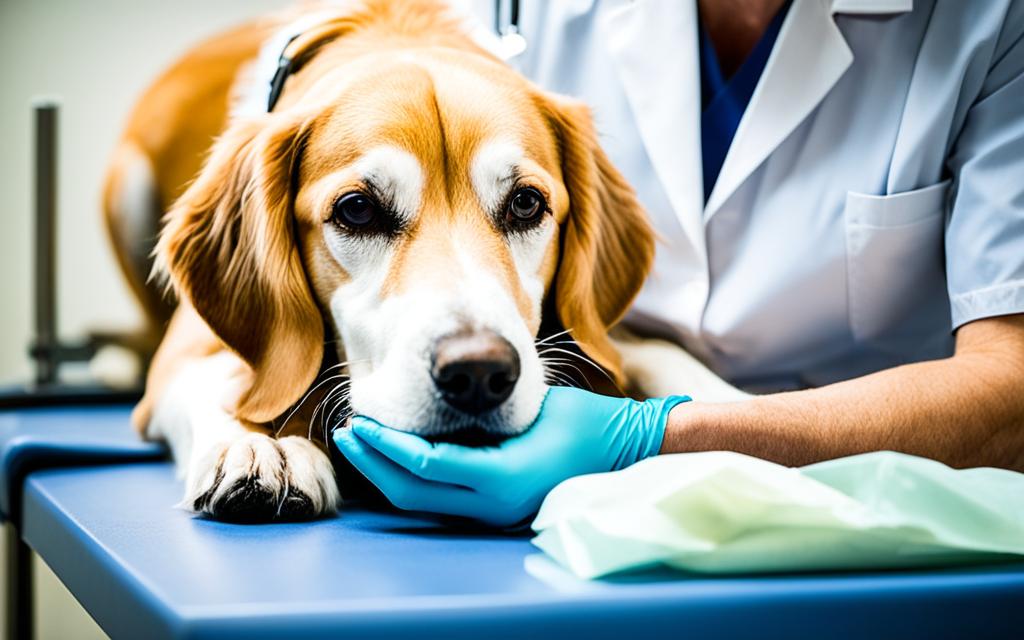
Pyometra Dog Disease. Did you know that pyometra, a serious infection in the uterus, affects up to 23% of intact female dogs over the age of six? This life-threatening condition can have fatal consequences if left untreated. Pyometra is a result of hormonal changes in the reproductive tract and typically occurs within weeks after a dog’s heat cycle. Recognizing the symptoms and seeking prompt veterinary care is crucial to ensure the best outcomes for your furry companion.
Key Takeaways:
- Pyometra is a life-threatening infection in the uterus of intact female dogs.
- The condition is a result of hormonal changes and usually occurs after a heat cycle.
- Untreated pyometra can have fatal consequences, making prompt veterinary care essential.
- Spaying is the most effective preventive measure.
- Surgical removal of the uterus and ovaries is the preferred treatment.
Causes and Risk Factors of Pyometra in Dogs
Pyometra, a dangerous and potentially life-threatening infection in female dogs’ uteruses, is primarily caused by hormonal changes in their reproductive tract.
After the heat cycle, the uterine lining thickens in anticipation of pregnancy. If no pregnancy occurs, the lining continues to thicken, resulting in the formation of cysts within the uterus. These cysts lead to a condition called cystic endometrial hyperplasia, creating an optimal environment for bacterial growth.
Furthermore, the high levels of progesterone in the female dog’s body prevent the contraction of uterine muscles, thus inhibiting the expulsion of bacteria and pus. This hormonal influence contributes significantly to the development of pyometra.
Several risk factors can contribute to changes in the uterus and increase the likelihood of pyometra. The use of progesterone-based drugs, as well as estrogen or synthetic estrogen drugs, can disrupt the delicate hormonal balance and predispose dogs to the disease.
It is crucial to note that intact females receiving hormonal treatments must be closely monitored to detect any signs of pyometra development. Regular veterinary check-ups are essential to ensure early detection and timely intervention.
The Role of Hormonal Changes
Hormonal changes play a pivotal role in the development of pyometra. Understanding this mechanism helps veterinarians and dog owners recognize the early signs of the disease and seek appropriate treatment.
“Hormonal changes in a female dog’s reproductive tract contribute to the development of pyometra. These changes can be influenced by factors such as the use of hormone-based medications. Recognizing the risks and being vigilant can save a dog’s life.” – Dr. Sophia Brown, Canine Reproductive Specialist
By addressing the underlying hormonal imbalances and closely monitoring females receiving hormonal treatments, the risk of pyometra can be minimized.
Hormonal imbalance in the reproductive tract of female dogs can lead to the development of pyometra. The image above highlights the complex hormonal changes and their potential impact on the uterus, providing a visual representation of the condition.
Symptoms and Diagnosis of Pyometra Dog Disease
The clinical signs of pyometra depend on whether the cervix is open or closed.
In cases where the cervix is open, there may be a purulent discharge from the uterus that can be observed externally.
Fever, lethargy, anorexia, and depression may also be present.
| Symptoms of Pyometra | Diagnosis of Pyometra |
|---|---|
|
|
If the cervix is closed, the discharge accumulates in the uterus, causing distention of the abdomen. Dogs with closed pyometra become severely ill, exhibiting symptoms such as anorexia, listlessness, vomiting, diarrhea, and increased water intake.
In the diagnostic process, veterinarians may conduct a physical examination to assess the dog’s overall condition and look for signs of abdominal distention. Blood tests are performed to detect an elevated white blood cell count and abnormal globulin levels, indicating an infection. Urinalysis is crucial to assess kidney function, as pyometra can affect kidney health. Radiographs or ultrasound may be used to visualize the uterus, confirming the presence of pyometra and assessing its severity.
Early recognition of the symptoms and prompt veterinary diagnosis are vital to ensure timely treatment and improve the prognosis for dogs with pyometra.
Treatment Options for Pyometra Dog Disease
The preferred treatment for pyometra is surgical removal of the uterus and ovaries through an ovariohysterectomy (spay). This procedure is more complex than a routine spay and requires the dog to be stabilized with intravenous fluids before and after surgery. Antibiotics are also administered post-operatively.
While surgery is the recommended treatment, there is a medical approach using prostaglandins to induce contractions and expel bacteria and pus. However, this method has variable success rates and potential complications, including side effects and the risk of uterine rupture. Ultimately, the choice of treatment depends on the individual dog’s condition and the veterinarian’s recommendation.
Benefits of Surgical Treatment
- Complete removal of the infected uterus and ovaries
- Eliminates the risk of future pyometra
- Reduces the risk of other reproductive diseases
- Can be performed simultaneously with spaying to prevent future heat cycles and unwanted pregnancies
Considerations for Medical Treatment
“While medical treatment using prostaglandins may be an option for some cases, it is important to weigh the potential risks and benefits. Dogs undergoing medical treatment should be carefully monitored for any adverse effects and the success of treatment should be assessed.” – Dr. Emily Thompson, DVM
In certain situations where surgical intervention is not possible, such as in older or high-risk dogs, medical treatment may be a viable alternative. However, the decision should always be made in consultation with a veterinarian, taking into account the dog’s overall health, the severity of the infection, and the potential risks involved.
In cases where surgery is performed, it is crucial to ensure proper post-operative care, including monitoring for signs of infection, administering prescribed medications, and scheduling follow-up visits with the veterinarian. By providing diligent veterinary care and following the recommended treatment plan, dog owners can give their furry companions the best chance of full recovery from pyometra.
Prevention of Pyometra Dog Disease
The most effective way to prevent pyometra is through early spaying of female dogs that are not intended for breeding. Spaying removes the risk of hormonal changes and eliminates the possibility of developing pyometra. It also reduces the risk of other reproductive diseases, such as mammary tumors. Delaying spaying increases the chances of pyometra development.
Discussing the risks and benefits of spaying with a veterinarian is essential to make an informed decision. Regular veterinary check-ups, proper hygiene, and prompt treatment of any reproductive abnormalities or infections can also help reduce the risk of pyometra.
| Prevention Tips | Benefits |
|---|---|
|
|
Risks and Complications of Pyometra Dog Disease
Pyometra is a serious condition that can have severe consequences if left untreated. The toxins released by the bacteria affect the kidneys, leading to increased urine production and excessive drinking. If the cervix is closed, the uterus can rupture, causing the infection to spread to the abdominal cavity, resulting in peritonitis, a life-threatening condition. Pyometra can also cause systemic illness and compromise the immune system. Therefore, early diagnosis and immediate treatment are crucial to prevent these complications and ensure the best outcomes for the affected dogs.
When pyometra is not promptly treated, the toxins produced by the bacteria can harm the kidneys, causing increased urination and excessive drinking. This can lead to dehydration and electrolyte imbalances, further compromising the dog’s health.
“If left untreated, pyometra can result in a ruptured uterus, allowing the infection to spread throughout the abdominal cavity. This can lead to peritonitis, a condition that is often fatal without emergency intervention.”
Additionally, pyometra can cause systemic illness, affecting multiple organs and functions within the dog’s body. The infection and inflammation can weaken the immune system, making the dog more susceptible to other diseases and infections.
To prevent these risks and complications, it is crucial to diagnose pyometra early and initiate immediate treatment. Monitor female dogs for any signs of illness, such as lethargy, decreased appetite, increased drinking and urination, or abnormal vaginal discharge. If any of these symptoms are observed, consult a veterinarian promptly.
Conclusion: Pyometra Dog Disease
Pyometra is a serious and potentially life-threatening infection that can affect female dogs. Understanding the causes, symptoms, and available treatment options is crucial for protecting our furry companions from this dangerous disease.
The most effective way to prevent pyometra is through the spaying of female dogs that are not intended for breeding. Spaying eliminates the risk of hormonal changes and significantly reduces the chances of developing pyometra and other reproductive diseases.
When it comes to treatment, surgical removal of the uterus and ovaries is the preferred option. This procedure, known as ovariohysterectomy or spay, removes the source of the infection and prevents future occurrences. It is vital to consult with a veterinarian to determine the best course of action based on the individual dog’s condition.
Regular veterinary check-ups and good hygiene practices can also contribute to preventing pyometra. By staying informed, proactive, and attentive to their dog’s reproductive health, owners can safeguard their beloved pets from the risks and complications associated with this potentially devastating condition.





















